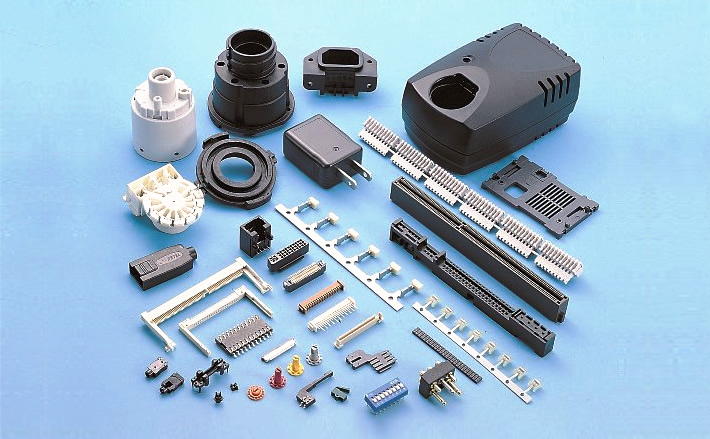Electronic Components

Application:
Electronic Market – Electronic parts for Mobile phone, Notebook, Computer, Monitor, Camera.
The injection department is 100% In-House tooling which provides speed-to-market advantage. MING-LI supplies the best quality optical parts to our valuable customers all over the world. Furthermore, our optical molding components are well-suited not only to the optical, but also the Electronic, Aerospace and Telecommunication industries.
-
In-house CPK Rate :≧ 1.33
-
Tolerance Range :Up to +/-0.005mm
-
Mold Size :600L*600W*600H ; up to 1,200kgs
-
Monthly Capacity :18 sets / Dies ; 15.8 million pcs / Overmolding & Injection parts
Product Material
-
Plastic Parts :LCP, PPS, PPA, PBT, PET, PC, POM, Nylon PA, PA6, PA66, PA9T, Derlin, Acrylic, etc.
-
Special Material :PEEK
The key elements for plastic injection Electronic Components parts
When it comes to manufacturing plastic injection-molded electronic components, several key elements need careful attention to ensure optimal performance, reliability, and functionality. Here are the essential aspects to consider:
-
Material Selection:
- Choose a plastic material suitable for electronic applications, considering factors such as heat resistance, flame retardancy, electrical properties, and chemical resistance.
- Common materials include ABS, polycarbonate (PC), polyamide (PA), polyethylene (PE), and various engineering-grade plastics.
-
Design for Manufacturability (DFM):
- Design electronic components with considerations for moldability, including draft angles, uniform wall thickness, and avoiding sharp corners or intricate features that could increase manufacturing complexity.
- Ensure that the design allows for proper gating, venting, and ejection during the injection molding process.
-
Mechanical Integrity:
- Design components with sufficient mechanical strength and rigidity to withstand handling, assembly, and operational stresses.
- Consider factors such as wall thickness, ribbing, and reinforcement to prevent warping, deformation, or mechanical failure.
-
Electrical Properties:
- Ensure that the plastic material and design features do not interfere with the electrical performance of the component.
- Design for proper insulation, conductivity, and EMI shielding as required by the application.
-
Heat Dissipation:
- Design components with features to facilitate heat dissipation and thermal management, especially for electronic devices prone to heat generation.
- Incorporate heat sinks, ventilation channels, or other thermal management features into the design as needed.
-
Surface Finish and Texture:
- Specify surface finish requirements to ensure smooth and defect-free surfaces that facilitate assembly and improve aesthetics.
- Consider texture requirements for grip, appearance, or functional purposes while ensuring compatibility with mold release and demolding processes.
-
Tolerances and Fits:
- Define appropriate dimensional tolerances and fits to ensure proper assembly with mating components and compatibility with electronic interfaces.
- Use GD&T principles to specify tolerances for critical dimensions and ensure proper alignment and functionality.
-
Integration of Features:
- Integrate features such as snap-fit connectors, mounting bosses, cable management channels, and PCB attachment points directly into the component design to streamline assembly and improve functionality.
-
Environmental Considerations:
- Evaluate the impact of environmental factors such as temperature, humidity, and exposure to chemicals on component performance and material stability.
- Select materials and design features that can withstand the intended operating conditions over the component's lifetime.
-
Quality Control:
- Implement rigorous quality control measures throughout the manufacturing process, including inspection of raw materials, in-process checks, and post-molding inspections.
- Utilize techniques such as dimensional inspection, visual inspection, and functional testing to verify component conformity to specifications.
By addressing these key elements during the design and manufacturing process, you can ensure the successful production of plastic injection-molded electronic components that meet the stringent requirements of the electronics industry in terms of performance, reliability, and manufacturability.
What must be cared for plastic injection Electronic Components parts molding?
When molding plastic electronic components, several critical factors need to be carefully considered to ensure the quality, functionality, and reliability of the parts. Here are key aspects to pay attention to during the plastic injection molding process for electronic components:
-
Material Selection:
- Choose a plastic material with suitable properties for electronic applications, including heat resistance, flame retardancy, electrical insulation, and chemical resistance.
- Ensure the selected material is compatible with the requirements of the electronic component and the molding process.
-
Mold Design:
- Design the mold with precision to replicate the desired features of the electronic component accurately.
- Consider factors such as gate placement, venting, cooling channels, and parting lines to optimize mold filling, part quality, and cycle times.
-
Injection Molding Machine:
- Select an injection molding machine with appropriate specifications for the size and complexity of the electronic component.
- Ensure the machine is capable of providing consistent temperature control, injection pressure, and cycle times to produce high-quality parts.
-
Injection Parameters:
- Fine-tune injection parameters such as melt temperature, injection speed, packing pressure, and cooling time to achieve complete filling of the mold cavity and minimize defects.
- Optimize parameters to prevent issues like flash, sink marks, warpage, or gate vestige that could affect the functionality of the electronic component.
-
Mold Temperature Control:
- Maintain precise control over mold temperature to ensure uniform cooling and minimize part shrinkage, warpage, or residual stresses.
- Use water cooling channels strategically to achieve consistent temperature distribution throughout the mold.
-
Quality Control:
- Implement robust quality control measures throughout the molding process, including inspection of raw materials, in-process checks, and post-molding inspections.
- Utilize techniques such as dimensional inspection, visual inspection, and electrical testing to verify component conformity to specifications.
-
Handling and ESD Protection:
- Take precautions to prevent electrostatic discharge (ESD) damage to sensitive electronic components during handling and assembly.
- Use ESD-safe packaging, equipment, and handling procedures to protect electronic components from static electricity.
-
Assembly Compatibility:
- Design the electronic component with features that facilitate assembly and integration into electronic devices or systems.
- Ensure proper alignment, fit, and compatibility with mating components and connectors.
-
Surface Finish:
- Control surface finish to meet requirements for aesthetics, functionality, and compatibility with coatings or adhesives.
- Implement texturing or polishing as needed to achieve the desired surface finish on the molded parts.
-
Documentation and Traceability:
- Maintain detailed records of process parameters, inspection results, and quality control data for traceability and documentation purposes.
- Document any deviations from specifications and corrective actions taken to address them.
By paying close attention to these factors and implementing best practices throughout the plastic injection molding process, you can ensure the successful production of high-quality electronic components that meet the stringent requirements of the electronics industry.
The plastic injection molding application for Electronic Components
Plastic injection molding plays a crucial role in the production of a wide range of electronic components due to its efficiency, precision, and versatility. Here are some common electronic components manufactured using plastic injection molding:
-
Enclosures and Housings:
- Plastic injection molding is widely used to produce enclosures and housings for electronic devices such as smartphones, tablets, computers, routers, and consumer electronics.
- These enclosures provide protection, structural support, and aesthetic appeal for electronic assemblies.
-
Connectors and Sockets:
- Plastic injection molding is utilized to manufacture various types of connectors, sockets, and terminal blocks used in electronic devices and electrical systems.
- These components provide electrical connections for cables, wires, and PCBs in applications ranging from automotive to consumer electronics.
-
Switches and Buttons:
- Injection-molded plastic parts are commonly used to produce switches, buttons, keypads, and tactile components for user interfaces in electronic devices.
- These components provide tactile feedback and actuation mechanisms for controlling functions such as power, volume, and input selection.
-
LED Components:
- Plastic injection molding is employed to produce various components for LED lighting systems, including housings, lenses, diffusers, reflectors, and light guides.
- These components help to shape, distribute, and protect light emitted by LEDs in applications such as automotive lighting, architectural lighting, and consumer electronics.
-
Battery Components:
- Plastic injection molding is used to manufacture battery components such as battery holders, covers, caps, and trays for portable electronic devices, power tools, and industrial equipment.
- These components provide mechanical support, protection, and organization for batteries in electronic assemblies.
-
Sensor Housings and Mounts:
- Injection-molded plastic parts are employed to produce housings, mounts, and enclosures for various types of sensors used in automotive, industrial, medical, and consumer electronics applications.
- These components protect sensors from environmental factors, provide mounting options, and facilitate integration into electronic systems.
-
Microfluidic Devices:
- Plastic injection molding is utilized to fabricate microfluidic devices and components used in lab-on-a-chip systems, biomedical devices, diagnostic instruments, and analytical equipment.
- These devices enable precise control and manipulation of fluids for applications such as DNA analysis, drug delivery, and point-of-care testing.
-
Antennas and RF Components:
- Injection-molded plastic parts are used to produce enclosures, covers, and components for antennas, RF modules, and wireless communication devices.
- These components provide protection, insulation, and structural support while maintaining signal integrity and performance.
-
PCB Mounting Hardware:
- Plastic injection molding is employed to manufacture various types of PCB mounting hardware, including standoffs, spacers, clips, and brackets.
- These components provide mechanical support, spacing, and attachment options for mounting PCBs in electronic assemblies.
-
Customized Components:
- Plastic injection molding allows for the production of custom-designed electronic components tailored to specific requirements and applications.
- These components can include unique shapes, sizes, features, and functionalities to meet the needs of diverse electronic devices and systems.
Overall, plastic injection molding offers a versatile and cost-effective solution for manufacturing a wide range of electronic components with precision, consistency, and scalability, making it an integral part of the electronics manufacturing industry.



